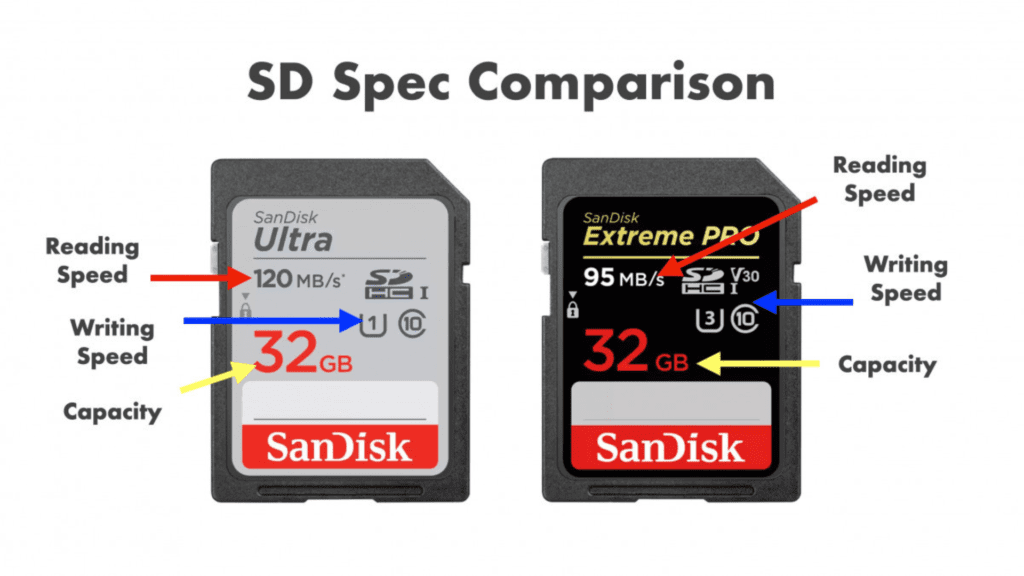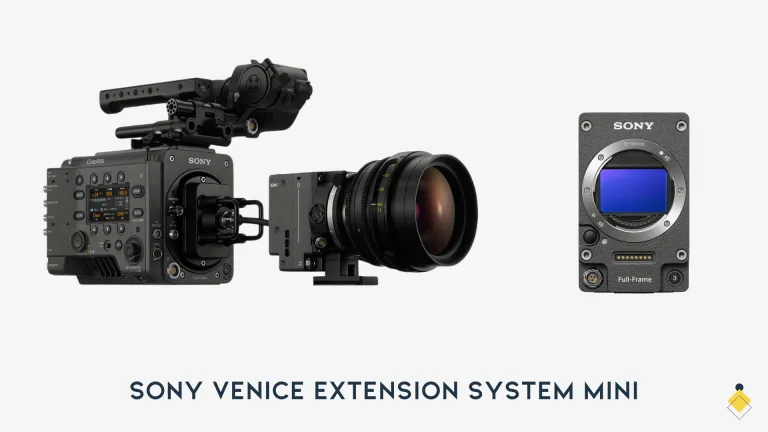When it comes to picking an SD card for your camera or other device, two of the top contenders are the Sandisk Ultra and Sandisk Extreme lines. But with several models available in each line, it can get confusing trying to determine the differences between Sandisk Ultra vs Extreme and which is the better choice for your needs.
This comprehensive guide examines the key distinctions between the Ultra and Extreme cards across criteria like speed, build quality, and price. We’ll compare Sandisk Ultra vs Extreme head to head so you can make an informed decision on the best SD card for your uses.
Speed Comparisons Between Sandisk Ultra vs Extreme

One of the most important factors when choosing an SD card is its speed rating, which determines how quickly it can write data from the camera to the memory card and read data from the card to display images and videos. This speed directly impacts your camera’s performance, including how fast it can take sequential shots, record video, and transfer files to your computer.
The two main speed ratings to look for are:
- Write speed – This measures how many megabytes (MB) per second the card can write data like photos and videos. Higher write speeds allow your camera to capture images more rapidly in burst mode and record higher-resolution video without slowing down.
- Read speed – This indicates the MB/s rating for reading saved data off the memory card. Faster read speeds let you quickly review images and videos on your camera and transfer files faster to your computer.
In general, Sandisk Extreme cards have markedly faster write and read speeds compared to similarly sized Ultra cards. Here’s a direct comparison of some current models:
- Sandisk Extreme Pro 32GB: Up to 90 MB/s write and 95 MB/s read
- Sandisk Ultra 32GB: Up to 80 MB/s write and 100 MB/s read
- Sandisk Extreme 64GB: Up to 90 MB/s write and 90 MB/s read
- Sandisk Ultra 64GB: Up to 80 MB/s write and 100 MB/s read
- Sandisk Extreme 128GB: Up to 90 MB/s write and 90 MB/s read
- Sandisk Ultra 128GB: Up to 80 MB/s write and 100 MB/s read
- Sandisk Extreme Pro 256GB: Up to 95 MB/s write and 90 MB/s read
- Sandisk Ultra 256GB: Up to 80 MB/s write and 100 MB/s read
As you can see, the Extreme cards provide significantly faster write speeds across the board, while still offering competitive read speeds. This makes them better suited for recording high-quality HD video, shooting rapid fire burst images, and saving photos simultaneously in RAW and JPEG formats which require a lot of write performance.
It’s also worth noting that Sandisk offers different “classes” for both Ultra and Extreme lineups based on speed. Lower class cards have reduced speeds and are marketed as budget options. These classes include:
- Class 4 = 4MB/s minimum write speed
- Class 10, U1, U3 = 10MB/s minimum write
- UHS Class 3 (U3) = 30MB/s minimum write
- V30 = 30MB/s minimum sustained write speed
- V60 = 60MB/s minimum sustained write
- V90 = 90MB/s minimum sustained write
Cards with a higher class rating will provide faster sustained speeds during recording video or continuous shooting. The Extreme lineup contains many V30 and V60 rated models not available in the Ultra line.
Build Quality and Durability

In addition to speed, Sandisk Ultra and Extreme SD cards differ in their physical build quality and ruggedness.
The Ultra line uses SanDisk’s standard engineering and construction, with the cards rated to survive up to 72 hours in one meter of salt or freshwater.
Comparatively, the higher-end Extreme cards utilize more durable components certified to withstand up to 72 hours in up to five meters of water, plus withstand shock, drops, x-rays, and extreme temperatures.
Sandisk uses terminology like “extreme”, “rugged”, “tough”, and “durable” to designate cards with higher durability. The Extreme line also comes with a lifetime limited warranty compared to the Ultra’s standard lifetime warranty.
Therefore, the Extreme series is better suited for use in harsh outdoor conditions and professional settings where the SD card may be subjected to lots of wear and tear. The reinforced casing provides extra protection when shooting sports, adventures, travel, and even harsh studio conditions.
Price
In terms of cost, Sandisk Extreme SD cards carry about a 30-50% price premium over similarly sized Ultra cards. The higher performance and reinforced build quality of the Extreme line comes at an added expense.
However, the improvements in speed and durability can be worthwhile for professionals or serious hobbyists, especially those capturing 4K or 8K video. The Extreme series is positioned as a prosumer and professional grade offering compared to the standard consumer-level Ultra counterparts.
Here’s a pricing comparison of some current SD card models:
- Sandisk Extreme 32GB: $14
- Sandisk Ultra 32GB: $10
- Sandisk Extreme 64GB: $20
- Sandisk Ultra 64GB: $13
- Sandisk Extreme 128GB: $25
- Sandisk Ultra 128GB: $18
- Sandisk Extreme 256GB: $40
- Sandisk Ultra 256GB: $32
As you can see, the cost difference is proportionally greater at lower capacities, though the Extreme remains a premium option even at high 256GB capacities. The Extreme Pro models sit above both series as Sandisk’s top-tier offering with max speed and durability.
Common Uses Cases

Due to the performance and price differences, the Sandisk Ultra and Extreme cards cater to different use cases.
The Ultra line offers a cost-effective solution for:
- Standard photo shooting
- Full HD video (1080p resolution)
- Casual video for social media
- Budget DSLRs and mirrorless cameras
Meanwhile, the Extreme series excels for:
- Professional photo shooting
- Burst mode image capture
- 4K and 8K ultra HD video recording
- RAW or RAW + JPEG photo formats
- High-end mirrorless and DSLR cameras
The Extreme’s combination of greater speeds, ruggedness, and pro-level features make it suitable for prosumers and professionals capturing important images or video they can’t afford to lose. And when your livelihood depends on reliable equipment, the Extreme’s premium is often worth paying.
However, casual users who don’t need the bleeding edge performance and durability can save money with the Ultra lineup without sacrificing too much functionality. The Ultra models remain solid memory cards for lighter-duty consumer use.
Sandisk Ultra vs Extreme: Key Differences
To summarize the key distinctions between the SanDisk Ultra and Extreme SD card lines:
- Speed – The Extreme cards offer significantly faster write speeds crucial for shooting burst images and 4K or 8K video. They maintain competitive read speeds with the Ultra series.
- Build Quality – Extreme SD cards use reinforced components certified to survive harsh conditions like shock, water, temperature extremes. They carry a lifetime limited warranty.
- Price – Extreme SD cards cost roughly 30-50% more than equivalent Ultra models. You pay a premium for the improved performance and durability.
- Best Uses – The Ultra lineup is ideal for budget photo and casual Full HD video shooting. The Extreme series excels for pro photos, 4K/8K video, and other intensive capture requiring speed and reliability.
So in choosing between SanDisk Ultra vs Extreme, consider whether the added speed and ruggedness benefits of the Extreme lineup are worth the higher cost for your particular needs. Casual users are well served by the solid performance and value of the Ultra cards. Enthusiasts and professionals who need pro-level capability will benefit from stepping up to the Extreme series.
Comparing Specific Models

Beyond the broad Ultra and Extreme lineups, Sandisk offers a wide range of SD card models at different capacities and speed classes. Here we’ll compare some specific models head-to-head.
Sandisk Extreme Pro vs Ultra
The Sandisk Extreme Pro line represents the top-tier offering from Sandisk, residing above both the Extreme and Ultra series. Extreme Pro models combine ultimate speeds and build quality for professionals and 4K/8K content creators.
Comparing the 256GB Extreme Pro to the Ultra 256GB reveals key differences:
- Write Speeds: Extreme Pro 95MB/s, Ultra 80MB/s
- Read Speeds: Extreme Pro 90MB/s, Ultra 100MB/s
- Durability: Extreme Pro higher water, shock resistance
- Warranty: Extreme Pro lifetime limited
- Price: Extreme Pro around $175, Ultra around $60
The Extreme Pro clearly delivers on speed and ruggedness. But it comes at around triple the cost of an Ultra 256GB, so it may be overkill for those not pushing their camera to the limits. The Ultra 256GB makes sense for most hobbyists. But professionals who need every ounce of performance should consider the Extreme Pro line.
Sandisk Extreme Plus vs Ultra Plus
Within both the Extreme and Ultra families, Sandisk offers “Plus” variants that deliver higher sustained write speeds for recording intense 4K video. Comparing the 64GB models yields:
- Write Speeds: Extreme Plus up to 90MB/s, Ultra Plus up to 80MB/s
- Read Speeds: Extreme Plus up to 170MB/s, Ultra Plus up to 100MB/s
- Warranty & Durability: Extreme Plus higher water/shock protection
- Price: Extreme Plus around $35, Ultra Plus around $25
The Plus versions provide noticeable speed boosts over standard Ultra and Extreme cards. Again the choice comes down to whether the improved performance and build quality justify the added cost for your needs. For hobbyists, the Ultra Plus offers good 4K video recording at a friendlier price point. But professionals may want the extra speed margins of the Extreme Plus models.
Sandisk Extreme vs Extreme Plus
Within the Extreme family, the standard Extreme and Extreme Plus models represent two tiers of performance and price. Let’s examine two 128GB cards:
- Write Speeds: Extreme Plus 155MB/s, Extreme 90MB/s
- Read Speeds: Extreme Plus 170MB/s, Extreme 90MB/s
- Durability: Equally rugged
- Price: Extreme Plus around $55, Extreme around $40
Here the Plus version includes V30 and A2 ratings for sustained 4K video recording and app performance. The nearly double write and read speeds make it the choice for advanced content creation. But the standard Extreme 128GB still provides strong performance for high-end photo and 4K video for $15 less.
Sandisk High Endurance vs Ultra
While not part of the Extreme family, Sandisk’s High Endurance microSD cards warrant a comparison to the Ultra lineup:
- Write Speeds: Ultra 80MB/s, High Endurance 30MB/s
- Read Speeds: Ultra 100MB/s, High Endurance 100MB/s
- Durability: High Endurance much higher
- Warranty: High Endurance lifetime limited
- Price: Similar
As the name suggests, these High Endurance cards sacrifice speed for ultra ruggedness to endure harsh security camera, dash cam, and monitoring conditions involving extensive rewriting. The Ultra offers much faster performance. But for write-intensive use cases demanding longevity, the High Endurance line is engineered to withstand extreme conditions.
Conclusion
When choosing the best SD card for your camera, compromises exist between price, performance, and durability. Key differences in these areas make the Sandisk Ultra cards suitable for mainstream use by casual users, while the Extreme family offers enhanced speeds and resilience to meet the demands of professionals and media creators.
Think about your own needs and uses when deciding if the advantages of the Sandisk Extreme are worth the added cost over the Ultra models. Those capturing important events or high-quality UHD video will benefit most from the Extreme series. However, more casual photo hobbyists can still get solid performance and value from the Ultra lineup.
FAQ – Sandisk Ultra vs Extreme
The main difference lies in their read and write speeds and performance capabilities. The Extreme series is designed for professional use and offers higher read and write speeds compared to the Ultra series, which is more suitable for general use.
The primary differences include their speed class, where the Extreme cards are often UHS Speed Class 3 and the Ultra cards are UHS Speed Class 1 or 3, and their intended usage – with Extreme being optimized for high-performance tasks such as 4K video recording and Ultra being more suitable for everyday use.
If you require high-speed data transfer and efficient performance, particularly for tasks like 4K video recording, then you should choose the Sandisk Extreme microSD card. For more general use, the Sandisk Ultra microSD card may be more than sufficient.
This depends on your specific requirements. If you need higher speed and performance for professional use or demanding tasks, then the Extreme would be a better choice. For regular use in cameras, smartphones, or other devices, the Ultra may suffice.
The Extreme Pro cards are the highest-performing models in the Sandisk lineup, offering even faster read and write speeds compared to the Extreme cards. They are designed for professional use and demanding tasks where speed and reliability are crucial.
While the Sandisk Ultra SD cards are generally capable of recording high-definition videos, they may not be optimized for very high bitrate recordings, such as 4K videos, in the same way that the Extreme series is. It’s advisable to check the speed class and requirements of your specific recording needs.
The “V30” label denotes that the card is capable of sustained write speeds of at least 30MB per second, making it suitable for recording high-definition video content, such as 4K. It’s an important indicator for those seeking high-performance memory cards.
The main features to consider are their read and write speeds, speed classes, and intended usage scenarios. The Extreme series offers faster performance and is geared towards professional and demanding applications, while the Ultra series is more suited to regular consumer needs.
For high-performance and high-resolution photography or videography, it’s advisable to select the Sandisk Extreme memory card due to its faster read and write speeds. For casual photography and general use, the Sandisk Ultra memory card may suffice.
In general, the Sandisk Extreme memory cards offer significantly faster read and write speeds compared to the Sandisk Ultra cards, which makes them more suitable for tasks that require higher data transfer rates and performance, such as 4K video recording and professional use cases.





